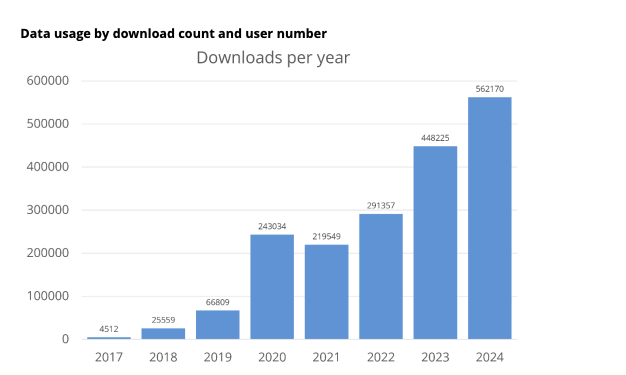
Throughout the ten years of ICOS ERIC, the number of data downloads has increased steadily, as the influence of ICOS has grown and more users have found their way to ICOS data. In 2024, ICOS reached the milestone of more than 500,000 data downloads.
The positive trend has continued into the first half of 2025. As of late June 2025, the ICOS Carbon Portal reports that total data downloads have reached 560,000. Of these, 416,000 are ICOS data, while the remainder consists of contributed non-ICOS data distributed through Carbon Portal. Data downloads can be explored by anyone in real time at https://data.icos-cp.eu/stats/
“The number of actual downloads is much higher when we exclude downloads from bots and our own facilities”, Alex Vermeulen Director of the ICOS Carbon Portal says. “When we include these, the number of downloads is more than 2 million per year."

One example of this is the most downloaded individual dataset from the Global Carbon Project (GCP), an organisation that seeks to quantify global greenhouse gases and their sources. The GCP is formed by a community of international scientists, including scientists from the ICOS community. ICOS has hosted Global Carbon Project data since 2017 at https://www.icos-cp.eu/science-and-impact/global-carbon-budget.
“As always the Global Carbon Project files still have the highest download numbers per file, but overall they get less than 1% of all downloads, and the number of downloads by GCP decreased a bit since a peak in 2022”, Alex Vermeulen comments.

Some other widely downloaded datasets include all ICOS level 2 final quality-controlled data products that find wide use in the domains of atmosphere, ecosystem and ocean sciences.
ICOS data is used around the world
ICOS data is used globally, except for North Korea and five countries in Africa.
“We see especially a lot of downloads from China, almost 20% of the total. Most interest is still from EU-27 and the USA, then Ukraine and the UK. In recent years Brazil is runner up”, Alex Vermeulen says.
ICOS data is used across a wide range of research fields, with most publications coming from Earth Sciences, Atmospheric Sciences, Biological Sciences, Geomatic Engineering, Ecology, Environmental Sciences and Agricultural Sciences.

Carbon Portal distributes data and develops services for researchers
Beyond providing access to data, the Carbon Portal actively develops tools and services to support data analysis and management. The most widely used tools include the Jupyter Notebook and the STILT footprint tool. The former is a tool for virtual collaboration and education, and the second is a visualisation tool for natural and human caused emissions.
In addition, the Carbon Portal continues to improve the usability of the data portal. Recent updates include improvements in the search interface and for previewing data.
“We recently improved the use of keywords in the search interface, so that only the keywords found in the metadata of the currently selected data are shown. When a keyword is removed, all datasets with that keyword are removed from the search results. This makes it much easier for users to find exactly the datasets they are looking for. We have also improved our data previews to scale better with different display sizes and will soon introduce a more flexible preview option for newer data types”, Alex Vermeulen says.
To keep the positive trends going in the future, ICOS data users need to remember just one simple thing – to cite their data. Citing and acknowledging ICOS data is not only a requirement, but also a way to show appreciation to the people in the network who make the data accessible and usable.
This story is part of a series created for the 10-year anniversary of ICOS, looking back at a decade of ICOS science and achievements. Read the rest of the stories here.
Read more: